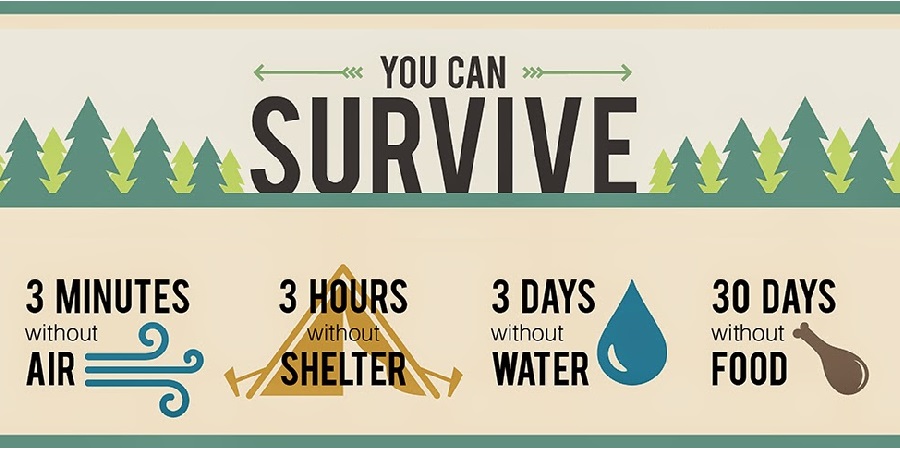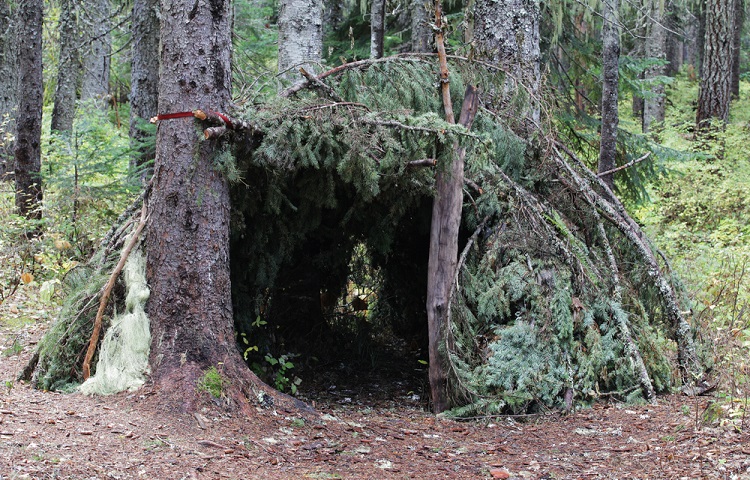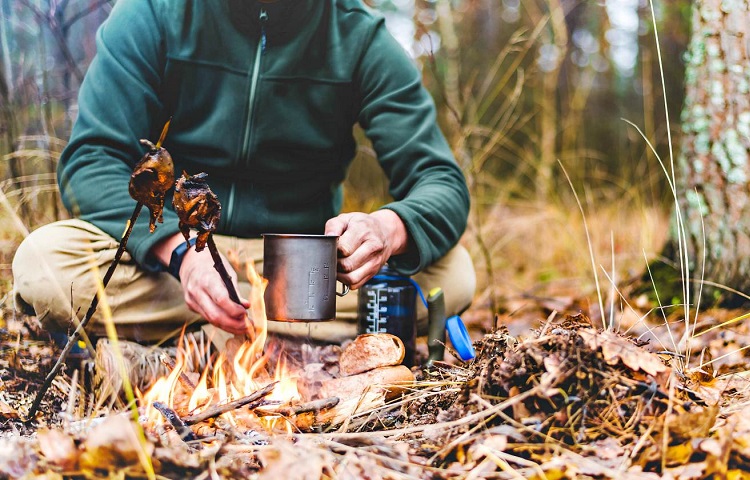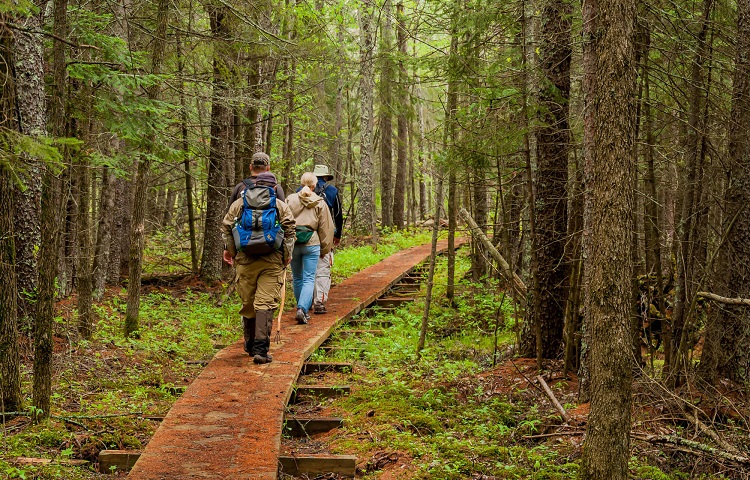No matter who you are or where you come from, being well prepared for any situation is something that everyone should strive for.
Whether it is an apocalyptic type event, a blackout or power crysis, or simply an unexpected night spent out in the wilderness, equipping yourself with the knowledge and expertise to survive is very important.
Preparing for the worst may seem like an unnecessary precaution, until circumstances arise and your preparation pays off. When the day comes that your survival skills are tested and come in handy, you will thank yourself for being proactive and preparing for the worst!
Let’s talk about some of the survival basics, more specifically the survival rule of 3 and its many applications.
Survival Rule of 3

Survival situations can involve many different factors. In these high stress scenarios, it is important to remember and prioritize your actions based on the four main aspects of the survival rules of 3:
- It is possible to survive for 3 minutes without air (oxygen) or in icy water
- It is possible to survive for 3 hours without shelter in a harsh environment (unless you are in icy water)
- It is possible to survive for 3 days without water (if you are sheltered from a harsh environment)
- It is possible to survive for 3 weeks without food (if you have water and shelter)
One of the main uses for the survival rules of 3 is the fact that you must focus on the most immediate survival issue first, before considering other factors. It may seem as though it is geared towards survival situations in an outdoor environment or wilderness context, but no matter your situation, these rules or guidelines are still applicable.
When we refer to the importance of following the order of these rules, we are evaluating the relative need to prioritize them based on immediate threat to human life.
For example, there is no need to be concerned about a shortage of food if the main situational threat to your survival is hypothermia because you are in a harsh cold environment with no shelter. The immediate threat, based on where it falls in our survival rules of 3 breakdown, is what should be your ultimate focus.
Let’s take a look at each situation and discuss a little bit more about the general and specific aspects associated with these survival rules of 3, starting from the most immediately threatening scenarios.
3 Minutes Without Air

Any scenario in which a human’s ability to breathe is compromised and their body cannot circulate the oxygen that it needs to survive is an immediate survival situation.
Our bodies essentially breathe autonomously for us, to the point where it is almost entirely subconscious and we do not need to actively focus on taking that next breath. With that being said, when our breathing is restricted, we are immediately aware of the situation and will naturally start to panic.
The constant availability of oxygen for the human body to survive is of utmost importance, and as a result is the highest priority of the survival rules of 3. When oxygen is not available, the process of asphyxiation will begin to occur. If oxygen flow is not restored within approximately, internal organs will shut down and death will inevitably occur.
There are a number of potential causes for asphyxiation. Some of the most common and most important causes to be aware of are:
Choking/Blocked Airway
Choking will happen when a foreign object becomes lodged in the airway and blocks off the body’s passage for oxygen. This can be a piece of food that was not properly chewed or was swallowed incorrectly, something from the surrounding environment or any number of other possible blockages.
Choking can also occur when a person experiences an alcohol overdose. Toxic levels of alcohol in the human body can compromise a person’s gag reflex, which in turn could cause them to choke on their own vomit or other bodily fluids while intoxicated.
Strangulation
Strangulation is another potential cause for asphyxiation. This occurs when a significant amount of pressure is applied on the throat, causing the airways to be constricted or closed. This will reduce a person’s ability to properly intake and circulate oxygen, and if the pressure is not relieved will result in death. You got because you, you
Drowning
Drowning is a type of asphyxiation that occurs in humans when the mouth and nose are submerged in a liquid and effectively blocked from taking in oxygen. When this occurs, the body’s tissues and organs will not receive the oxygen they need to function and will shut down causing death.
Chemical Asphyxiation
Chemical asphyxia occurs when someone inhales some type of chemical compound that acts to cut off the body’s oxygen supply. These chemicals are called asphyxiants, and can be produced by a number of everyday household products.
One of the most common potentially deadly asphyxiants is carbon monoxide, which is an odourless gas that if inhaled in excessive amounts can cause carbon monoxide poisoning.
It is produced by things like water heaters, furnaces, gas ovens, motor vehicles and boilers. Make sure you have a carbon monoxide detector installed in your home, and regularly check to ensure that it is functioning properly.
3 Hours Without Shelter

The second survival rule of three is the fact that the human body can typically survive three hours without shelter. When breathing and proper oxygen flow is established and under control, the second most immediate potential threat to survival is being exposed to the elements with no shelter.
When the human body is subjected to a situation that involves extreme heat or extreme cold, in most cases it is only possible to survive for 3 hours without some sort of shelter.
Examples of extreme weather would be events like a blizzard, hailstorm or a scorching heatwave. The human body is equipped to deal with extreme conditions like these to a certain degree, however finding some sort of shelter is crucial to improving your chances of survival.
In a survival situation, keep in mind the fact that the human body will survive for about 3 hours without shelter in extreme weather.
3 Days Without Water

The survival rule of 3 also indicates the fact that the human body cannot survive without water for more than 3 days. Water is undoubtedly one of the most important things that humans need to stay functioning and stay alive.
The fact that we are made up of up to 60 percent water, while vital organs like the heart and the brain are both made up of over 70 percent water, proves how much we truly rely on water for vital processes.
Keeping your body hydrated is crucial to survival. If you cannot maintain a consistent clean water supply, your body will become dehydrated to the point where vital organs and tissues will shut down, causing death.
When you are making plans to travel or head out into the wilderness, one of the very first steps to take is ensuring you have a water source that will provide sufficient hydration.
Water bottles and hydration backpacks are great ways to transport a substantial water supply. It is also not a bad idea to bring along a water purification system of some sort (tablets, boiling apparatus), in case you find a water source that needs to be filtered before it is safe to drink.
Always remember that 3 days without water is your threshold for survival. Be prepared!
3 Weeks Without Food

Our final survival rule of three states that the human body can go approximately three weeks without some sort of food.
In comparison to sufficient shelter and oxygen, this is less important as three weeks is a relatively long period of time and therefore hunger will not pose an immediate survival threat.
However, an extended period of time without some type of sustenance is potentially life threatening if access to food is not achieved.
During normal circumstances where nutrition is readily available, the body breaks food down into glucose which provides energy. When the glucose storages in the body have been depleted, the body will start to burn through fat stores in order to create ketones for energy.
Once all of the fat deposits have been burned through, the body will revert to burning muscle in order to sustain itself. At this point, you will be experiencing significant weight loss and a myriad of other symptoms.
If the body does not get the chance to be refueled, it will slowly shut down vital processes and death will occur.
How To Boost My Survival Chances
Boosting your chances of survival can be achieved by properly preparing yourself for a variety of situations.
We have compiled a list of important aspects to consider and precautions to take in order to boost your chances for survival when extreme scenarios come to fruition.
Master your emotions
Survival situations require clear thinking and level-headedness. It is important to be able to manage your emotions and refrain from allowing yourself to enter into a state of panic. Stay focused on the situation at hand and think logically. Use your skills and knowledge to take the necessary action and survive.
Be prepared
No matter how knowledgeable you are when it comes to survival situations, it is always incredibly important to be prepared. Aside from preparing yourself with important knowledge, it is crucial that you prepare yourself with appropriate equipment and gear to provide survival assistance.
Things like rope, a firestarter, clean water or a water purifying apparatus, a tent, proper clothing, and countless other potentially life saving items should be on your list. Depending on your environment and the potential survival situations you could be facing, prepare yourself accordingly.
Travel in a group

Embarking on expeditions alone is quite often a recipe for disaster. If you find yourself in some sort of survival situation, being solo is often going to significantly reduce your chances of coming out alive.
Having other people to help with physical elements like lifting or building, and mental elements like devising plans and providing emotional support is incredibly important. There is power in numbers, remember that.
If you MUST be on your own for whatever reason, always be sure to let someone know exactly where you are going, and when you plan to be back. If something does end up going wrong, this person will know where to look and when to start looking.
Know your limits
Knowing your own personal limits is another very important thing to remember. Evaluate your physical and mental fortitude, and when planning or deciding on potential activities or trips, consider what you think you and your body can handle. Being aware of and
honest about what you can and cannot do as a human being will help you decide what situations to embrace and which ones to stay away from. Know your limits and live within them!
Conclusion
Building a solid basis of knowledge and expertise when it comes to survival is a very important step to take towards being able to live through a survival situation. Understanding the human body and how it reacts to various stressors is a crucial part of that knowledge.
We have discussed the main aspects of the survival rule of 3, which involves the body’s relative ability to withstand certain situations. We have covered some of the details associated with each rule, including how the body will react and how death can occur.
We also discussed some of the most important steps to take and things to remember in order to increase your chances of survival in any situation.
Keep these things in mind and always remember that survival preparation and the associated knowledge can be the difference between life and death.
References


[lasso rel="emergency-preparedness-more-a-manual-on-food-storage-and-survival-2nd-edition-revised-and-updated" id="35334"]